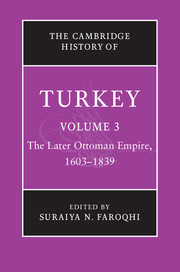Book contents
- Frontmatter
- PART I BACKGROUND
- PART II AN EMPIRE IN TRANSITION
- PART III THE CENTRE AND THE PROVINCES
- PART IV SOCIAL, RELIGIOUS AND POLITICAL GROUPS
- 10 The Ottoman ulema
- 11 Muslim women in the early modern era
- 12 The Ottoman Jews
- 13 Christians in a changing world
- PART V MAKING A LIVING
- PART VI CULTURE AND THE ARTS
- Glossary
- Bibliography
- Index
- References
11 - Muslim women in the early modern era
from PART IV - SOCIAL, RELIGIOUS AND POLITICAL GROUPS
Published online by Cambridge University Press: 28 March 2008
- Frontmatter
- PART I BACKGROUND
- PART II AN EMPIRE IN TRANSITION
- PART III THE CENTRE AND THE PROVINCES
- PART IV SOCIAL, RELIGIOUS AND POLITICAL GROUPS
- 10 The Ottoman ulema
- 11 Muslim women in the early modern era
- 12 The Ottoman Jews
- 13 Christians in a changing world
- PART V MAKING A LIVING
- PART VI CULTURE AND THE ARTS
- Glossary
- Bibliography
- Index
- References
Summary
Representations: women between ‘East and West’
In the Ottoman East as in other societies, women’s lived experience and society’s representation of women seldom coincided. In early modern Istanbul and Damascus, as in London and Lyons, or for that matter ancient Rome and Athens, women’s lives were more complex and varied than their contemporaries were ready to concede. In Western and Mediterranean literary traditions, women’s daily lives, like the lives of most men, went unremarked. But unlike men, women tended to be aggregated into idealised or deplored versions of a collective self – women as they should be, set against the dire potential of the Eve within. It is not that real women, individual and identified, lacked social validity in Ottoman consciousness. Rather, the integral category of ‘womankind’, though undifferentiated by class, vocation, or creed, was more fully realised and answered larger cultural needs. ‘Womankind’ comprehended a stock of images expressive of society’s anxieties and aspirations. Sometimes very good, sometimes very bad, women as womankind were staples of moralists and belletrists a like. In those rare instances when ordinary women were permitted to touch ground in the literature, they were customarily limited to sexualised or domestic preoccupations.
For most of the seventeenth and eighteenth centuries, the depiction of Ottoman Muslim women did not differ significantly from their representation in earlier times. All in all, it was a story that was rarely told, at least for the written record. Even the genre of the privileged, that of illustrious women, is thin in comparison to its counterparts in early Islamic and contemporaneous European societies; few women are included at all, within a scant few categories of representation.
- Type
- Chapter
- Information
- The Cambridge History of Turkey , pp. 226 - 255Publisher: Cambridge University PressPrint publication year: 2006
References
- 3
- Cited by



